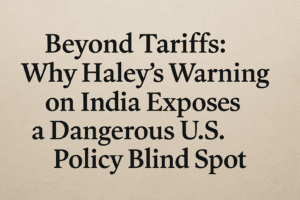Beyond Tariffs: Why Haley’s Warning on India Exposes a Dangerous U.S. Policy Blind Spot
Nikki Haley has issued a sharp warning against President Trump’s threat to impose steep new tariffs on India, arguing it risks severely damaging a vital strategic alliance. She highlighted a glaring contradiction: while punishing India – a key democratic partner – for buying Russian oil, Trump granted China, America’s top adversary and the largest purchaser of Russian and Iranian oil, a 90-day tariff pause. Trump justifies the move by citing high Indian tariffs and accusing India of “funding Russia’s war machine,” dismissing India’s offer to eliminate tariffs as insufficient.
India firmly defends its energy decisions as a sovereign right and points to ongoing Western trade with Russia as hypocrisy. Economists warn the tariffs could hurt India’s growth, with ICRA already downgrading its GDP forecast, and harm export-reliant sectors like textiles and auto parts. Haley contends this approach dangerously prioritizes short-term pressure on Russia over long-term U.S. interests by alienating a crucial counterweight to China in Asia.
Ultimately, the dispute reveals a damaging incoherence in U.S. strategy: punishing a critical ally more harshly than the primary adversary for similar actions undermines American credibility and inflicts lasting geopolitical costs.

Beyond Tariffs: Why Haley’s Warning on India Exposes a Dangerous U.S. Policy Blind Spot
Nikki Haley’s sharp rebuke of President Trump’s threatened tariff hike against India isn’t just political sparring – it’s a stark warning about a potential strategic blunder with global consequences. While the immediate headlines scream “trade war,” the underlying tension reveals a critical flaw in applying pressure inconsistently among nations with vastly different relationships to the U.S.
Haley’s Core Argument: Allies vs. Adversaries
Haley, leveraging her foreign policy credentials as former U.N. Ambassador, cuts to the heart of the issue:
- The China Contradiction: Her central point is undeniable hypocrisy. China, explicitly designated a strategic adversary by the U.S. and the undisputed top buyer of Russian and Iranian oil, received a significant concession – a 90-day tariff pause. This reward for an adversary stands in jarring contrast to the immediate, severe punishment threatened against India, a designated major defense partner and critical democratic counterweight to China in Asia.
- The Strategic Cost: “Don’t burn ties with a strong ally like India,” Haley warns. She underscores that alienating a nation central to U.S. Indo-Pacific strategy (through initiatives like the Quad) over oil purchases, while giving China a pass, fundamentally undermines U.S. credibility and long-term interests. It signals that alliances are transactional and easily discarded, regardless of broader strategic value.
- The Policy Incoherence: Punishing India more harshly than China for similar actions (buying Russian oil) signals a lack of coherent strategic prioritization. It suggests short-term political gestures (tough talk on Russia) override the long-term geopolitical necessity of nurturing key partnerships.
Trump’s Justification & India’s Stance
President Trump frames the threat purely through an economic and Russia-policy lens:
- High Indian Tariffs: He cites India’s historically high tariffs on U.S. goods as a longstanding grievance.
- Funding Russia’s War: He directly links the tariff escalation to India’s continued Russian oil imports, stating, “Zero tariffs aren’t enough when they’re helping fund a war we oppose,” dismissing India’s recent offer of zero tariffs as insufficient.
India, however, firmly rejects the premise of unfairness:
- National Interest & Sovereignty: New Delhi consistently asserts its right to secure affordable energy for its vast population, prioritizing national economic stability. They view energy sourcing as a sovereign decision.
- Western Hypocrisy: Indian officials point out that the U.S. and EU, despite vocal criticism of Russia, continue significant energy and trade dealings with Moscow themselves. They argue India is being unfairly singled out.
The Looming Economic Fallout
The threat isn’t just diplomatic noise; economic analysts are already adjusting forecasts:
- Growth Downgrade: ICRA revised India’s FY26 GDP growth projection down to 6.0% (from 6.2%), citing U.S. trade actions and policy uncertainty as key factors.
- Sectoral Vulnerability: Textiles, auto components, chemicals, and gems/jewellery – heavily reliant on the U.S. market – face significant competitiveness risks. India’s substantial $41 billion trade surplus with the U.S. is likely to shrink.
- Potential Bright Spots?: Pharmaceuticals (over 37% of exports to the U.S.), petroleum products, and telecom instruments may be less immediately impacted, though prolonged tensions could change this.
The Bigger Picture: A Strategic Crossroads
Haley’s intervention highlights a critical dilemma for U.S. foreign policy:
- Prioritizing Adversaries over Allies? The optics and substance of punishing India more severely than China for similar energy purchases damage U.S. credibility. It risks pushing India, a natural democratic partner, towards hedging strategies that diminish U.S. influence in the region.
- The Transactional Trap: Framing the vital U.S.-India relationship solely through tariffs and immediate compliance on Russia policy ignores decades of bipartisan effort to build strategic trust and shared democratic values. Reducing it to a single transactional issue is dangerously myopic.
- Unintended Consequences: Aggressive tariffs could trigger Indian countermeasures (like calls to “ground Boeing planes” or switch defense contracts), harming U.S. exporters and workers in key states, and fracturing supply chains.
The Insight: Beyond the Tariff Headlines
The real story isn’t just about potential tariffs on Indian goods; it’s about the fundamental incoherence of weakening a crucial democratic ally to make a point about Russia, while simultaneously easing pressure on the primary strategic adversary enabling that same Russian regime. Haley’s warning resonates because it exposes a potential strategic own-goal: sacrificing a long-term, hard-won partnership for a short-term, inconsistently applied punitive measure. How the U.S. navigates this moment – whether it heeds the call for strategic consistency or doubles down on transactional pressure – will significantly shape the balance of power in Asia and the future of its most important partnerships for decades to come. The cost of burning bridges with allies like India, as Haley rightly cautions, far outweighs any temporary tariff revenue.
You must be logged in to post a comment.